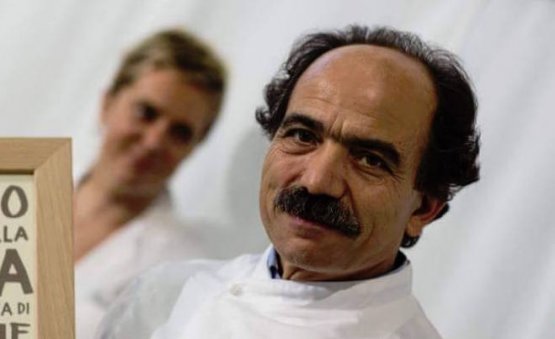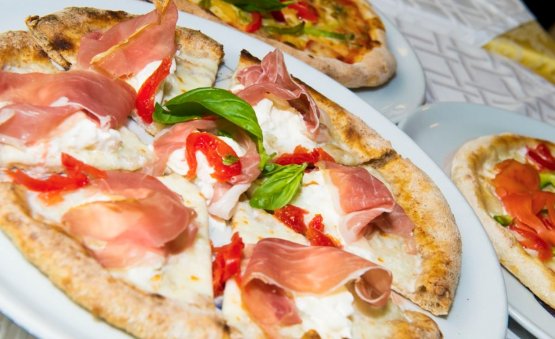“La Farina e il Fuoco” is the title of the nice documentary on contemporary Italian pizza filmed over on year ago at Università della Pizza in the ancient mill of the Quaglia family. And while when it comes to flour no mistakes are to be made – Petra, in this case – as for the fire, asking Carmine Nasti, born in 1951 in Tramonti is a good idea. Given his background, he could have sat comfortably on the placid – yet perfectible – tradition and just offer the same old things, without further hassles. Instead…
Instead a flame, that of knowledge was burning and is still burning in his heart. For a fire specialist, you’d agree, it’s even logical. He says: «Tramonti, on the Amalfi Coast, has an excellent tradition of pizza chefs, which is different from that of Naples». The latter requires a “violent” and short cooking, at around 450°C for 45-50 seconds, «this is why the disc sometimes appears a little burnt. Besides, at that temperature, how can you preserve the aromas of the topping?». Impossible, almost.

Tramonti’s popular tradition, instead, requires the pizza to stay in the oven for a longer time – 2 or 3 minutes– and with a temperature not exceeding 350°C, «so it becomes perfectly golden –
allampata, they say – and at the end it is crispy and aromatic, because we come from a peasant tradition, everyone would use the stone milled flour made with their own wheat. With pizza, we use the same technique we used to use with bread».
For 50 years
Nasti has been perfecting his cocktail of bestowed knowledge and acquired innovation. He’s a regular at
Università della Pizza: «I’ve always enjoyed improving myself. For pizza to be good, but also perfectly easy to digest, you need to pay attention to each phase: kneading, topping, baking». One year ago – he says – this mix was no longer enough, he was «at a point of no return. I asked myself: what are we serving our clients?».
Hence came the stimuli to do something different, and do it better: «The meeting with Università della Pizza was like a manna to me. At that time I was studying flour and stone mills. It was like projecting my past into the future – I remember the perfect aroma of old flour, cooked in large ovens, 2.5 metres wide and 1 metre tall. As a child I would go inside, when they were cold, to steal some slices of bread that had been toasted during the night. Pizza was put inside after the bread, the dough was made with whole wheat, aromatised with wild fennel».

One of Nasti’s pizzas. Notice the nice golden edge
Choosing to bake pizza at a more moderate temperature also allows choosing different ovens from wood ones: «Until the Eighties, it would have been blasphemy. Even today many turn up their noses when seeing an electric or gas oven, which is certainly less scenic». Yet managing the logs is not easy, their yield can vary greatly depending on the supply, plus there’s the problem of soot and smoke… «Sometimes the wood is dirty, sometimes it’s not of the right kind... This alters the pizza’s flavour. Or it finishes, and then you need to feed the oven with what you find, perhaps even fruit boxes: it’s terrible. Modern, electric or gas ovens, instead, guarantee the same standards, without any hassles. They don’t look as good, they’re not as charming, but that’s just a small thing: they cook perfectly».
Today
Nasti runs the family pizzeria in Bergamo (
Da Nasti), where his sons
Vittorio and
Riccardo also work, on top of his nephew
Carmine jr, while another nephew,
Giovanni, is promoting good pizza in the US, in Manhattan, at
Via della Pace Pizza. In Bergamo he runs a modern, rotating oven with double combustion, which means it works both with gas and wood, which is strictly from beech or olive trees, «because they don’t crackle, the embers are homogenous, they keep the temperature well and they’re clean, they make very little soot».
For 5 years
Nasti has been using mother yeast for his dough, «but I don’t demonise brewer’s yeast, which is more stable». He chooses a double leavening with poolish and by refining these technique he manages to keep the quality high.
As for the topping, cans are banned: only fresh products and in season. «My favourite pizza? I’d say marinara, with whole-wheat, provola, garlic, capers, olives and anchovies from Cetara. I don’t like toppings to be too complex. I think highly of Simone Padoan who presents them and is copied – well or not – by many. I’ve tried to as well, but I can’t guarantee a perfect product. I pull out of the oven even 300-400 pizzas per day. So I prefer simpler ingredients». The pizzas have therefore a classic look, unlike “focaccia”, but are served in slices, for a perfect tasting.